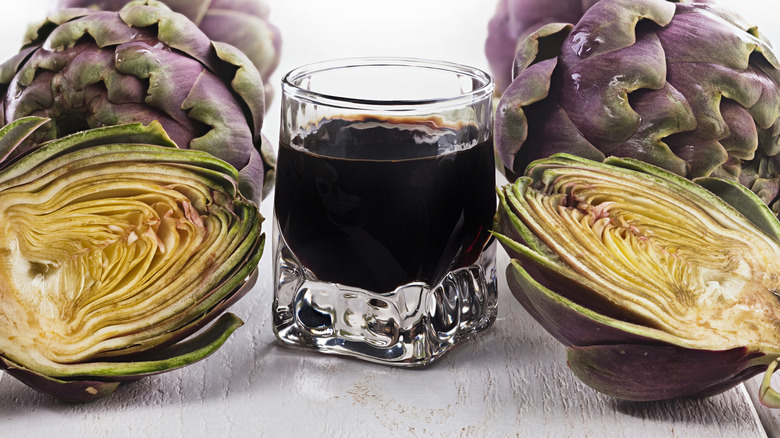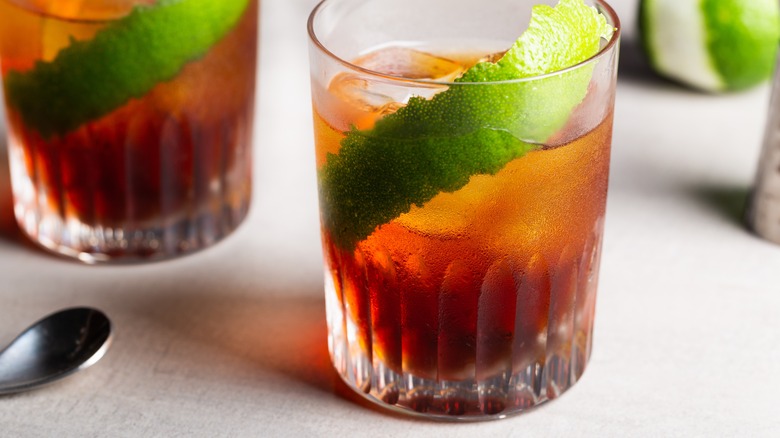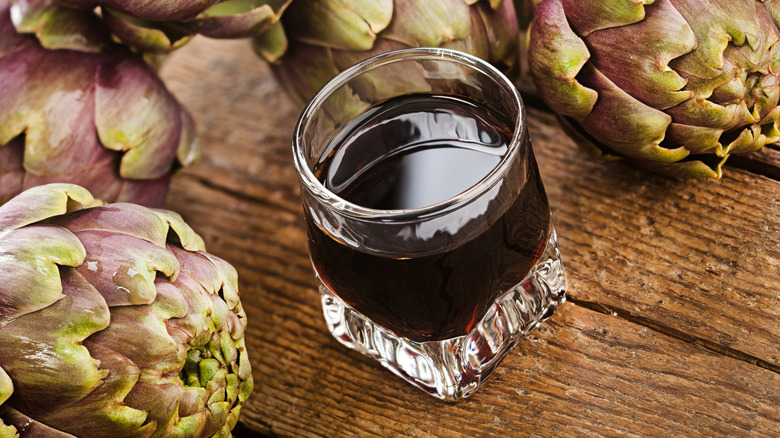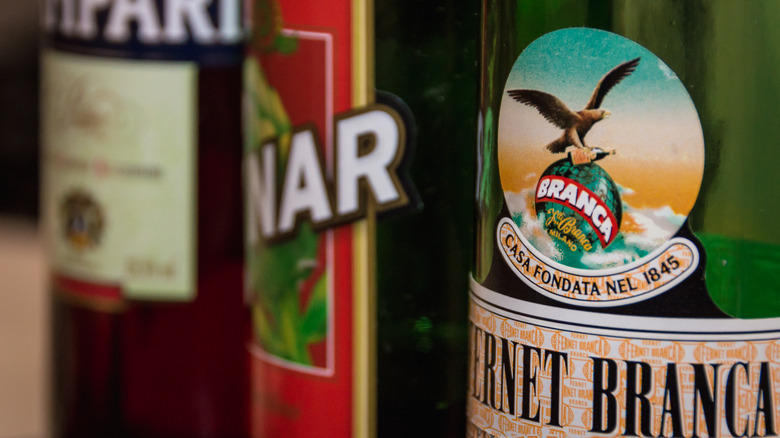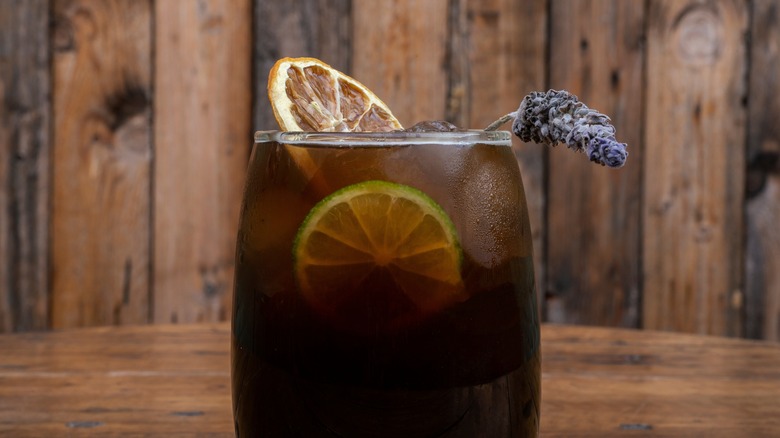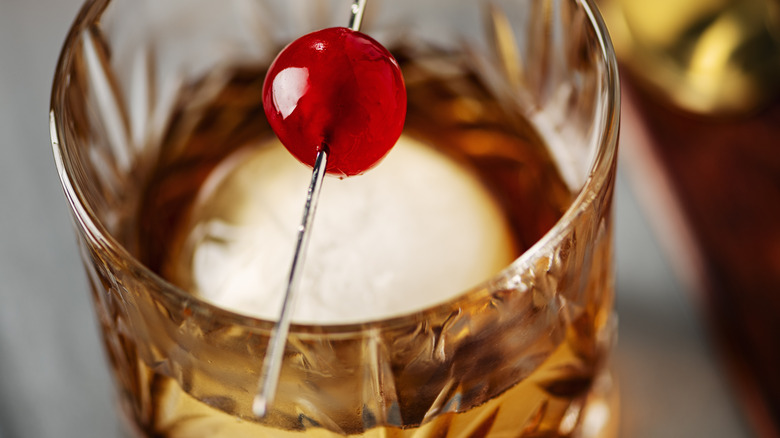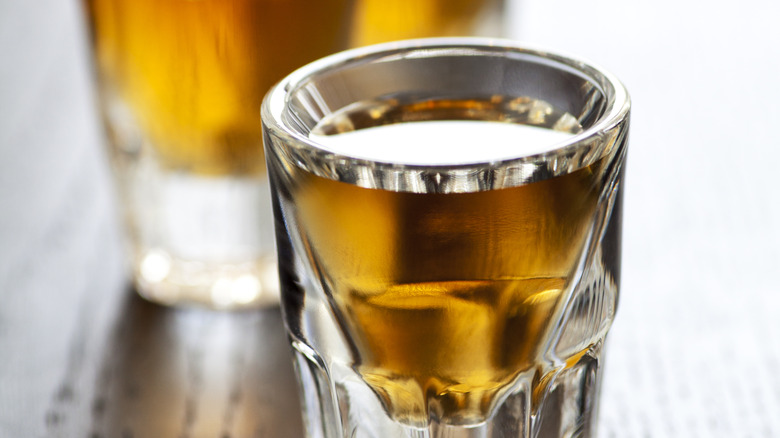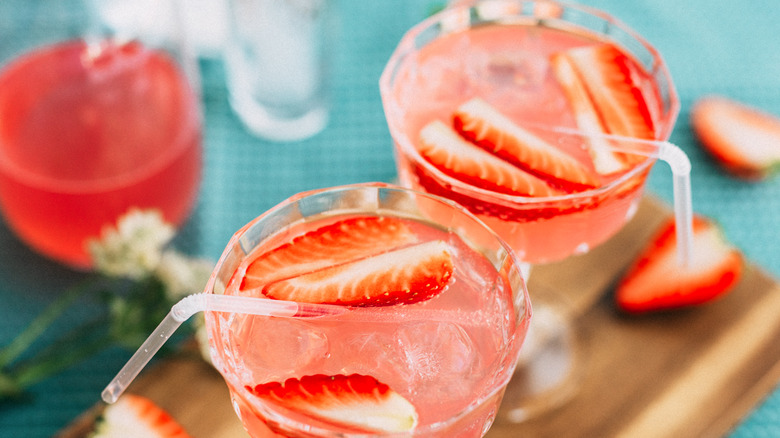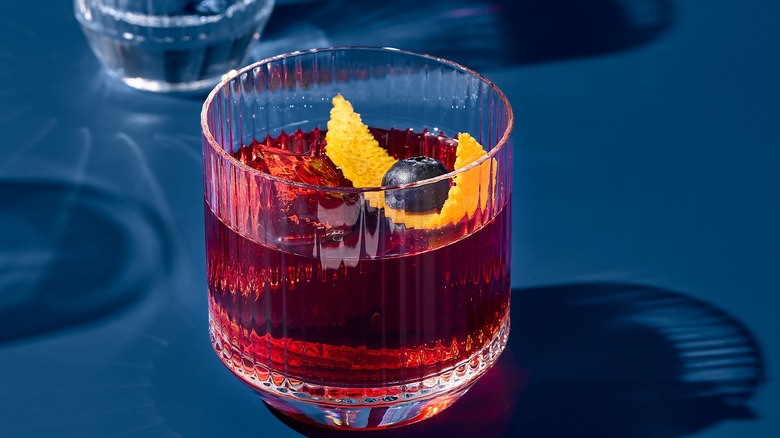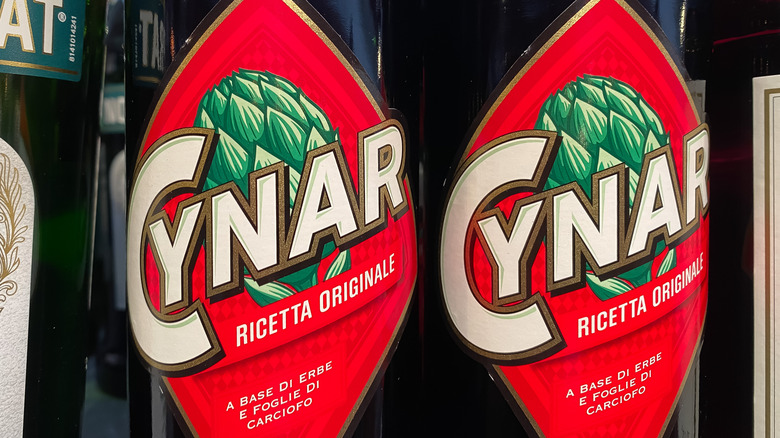Cynar: The Bitter Liqueur That Makes Simple Cocktails Taste Expensive
Unless you're a serious cocktail geek, it's unlikely you have a bottle of Cynar in your bar. You may have seen its distinctive bottle, with its bold red label and illustration of an artichoke, and figured it was one of those obscure cordials only used in a handful of equally obscure cocktails.
But Cynar (pronounced chee-nar) is not only worth knowing about, but worth experimenting with at home. It's technically an amaro (a liqueur with distinctly herbal, bitter notes — Aperol and Campari are other well-known amaros). While different types of amaro have been made in Italy for centuries, Cynar is one of the newer varieties, first developed in 1952. A dark brown liqueur, it boasts a complex flavor, bittersweet and a bit vegetal with a touch of smokiness. While it can be served straight as an aperitif or a refreshing and restorative after-dinner drink, it's also a great mixer. And as many a bartender will tell you, a splash of Cynar in any number of basic drinks will turn them into something special.
Cynar is a bartender favorite
If you enjoy craft cocktails, there's a good chance you've tasted Cynar without realizing it — it's become a favorite back-pocket ingredient among savvy American bartenders. Bartenders not only love the versatility of Cynar, but crave how it tastes on its own. "Cynar drinks great by itself," Max Reis, beverage director of Gracias Madre in Los Angeles, told Wine Enthusiast.
The fact that Cynar is relatively low in alcohol (the standard version clocks in at 16.5% alcohol) adds to its versatility, since it can bring depth and flavor to lighter cocktails without overpowering them. This also makes it a satisfyingly refreshing after-dinner drink that won't knock patrons out. But its real power comes from its deeply complex flavor, which seems to elevate everything it touches. And bartenders know that a shot of Cynar makes even the most ordinary drink memorable. Add some to Coca-Cola, for instance, and instantly turn an ordinary glass of soda into a sophisticated highball. Or serve a shot of Cynar with a glass of sparkling wine to make a festive drink even more special.
Are there actually artichokes in Cynar?
Yes, the artichoke on the Cynar label is there for a reason — the drink really is made from artichokes. This isn't as unusual as you may think: A number of amaros (bitter botanical liqueurs) are made with artichokes and related plants such as cardoons and thistles. This tradition of artichoke-related drinks dates back to Roman times, when cooks cooked down the tough, fibrous parts of these plants in wine or water. Cynar, however, is a relatively modern innovation, invented by Venetian entrepreneur Angelo Dalla Molle, who wanted to harness the artichoke's nutritional benefits (and alleged aphrodisiac properties) in the form of an amaro.
No, Cynar doesn't taste like artichokes — it also contains a blend of 13 other botanicals, which seem to do most of the heavy lifting in terms of flavor. But artichokes do lend a subtle vegetal note to the drink, and contribute their unique flavor in another way: They contain cynarin, a compound that temporarily blocks our ability to taste sweet foods. This is why many perceive artichokes as bitter. It's also why everything tastes sweeter after we've had a bite of artichoke — once a little artichoke is swallowed and our sweet-perceiving taste buds come back "online" again, everything seems unusually sweet in contrast to what came before. This effect also contributes to Cynar's intriguing balance between sweet and bitter.
Intimidated by bitter liqueurs? Try Cynar first
For many of us, sweet means good-tasting, while bitter means inedible. And even if you pride yourself on being open minded and aspire to be a serious connoisseur of food and drink, you still might find it challenging to get behind hoppy beers and bitter edibles such as arugula. And drinks with bitter liqueurs such as Campari as featured ingredients? You'll stick to your trusty White Russian, thank you very much.
It's not your fault: Humans evolved to distrust bitter foods, because for the most part, bitter things are neither safe nor desirable to eat. But there are exceptions, and serious mixologists have embraced the use of bitter ingredients to add depth and balance to cocktails. "Asking me to not make drinks with bitter elements like Cynar is like asking an artist to not paint with the color blue," Scott Carney, dean of wine studies at the Institute of Culinary Education, told Wine Enthusiast. Carney adds that if you're intimidated by the prospect of bitter drinks, Cynar is a good "gateway amaro," since it's sweeter and less harsh than other related drinks.
The recipe for Cynar is a closely guarded secret
Cynar proudly displays an artichoke (one of its featured ingredients) on its label. This is a bit of a red herring, though: While Cynar is indeed made with artichokes, they're just one of over a dozen other ingredients in the drink, and far from the dominant flavor. While the manufacturers will gladly reveal that it's made from a blend of 13 botanicals and herbs (along with enough sugar to balance the bitterness), the exact content of the signature herbal blend — which has remained unchanged since it was introduced — remains a closely protected secret.
This hasn't stopped a few people from trying to guess what at least some of them may be, however. One taster perceived faint notes of basil and oregano, while another guessed that lemon and gentian may be included. But Cynar is not the sort of drink that inspires a lot of copycat recipes, unlike other beloved commercial foods and drinks. This could be because the blend of botanicals is so seamless and balanced it's nearly impossible to tease any individual ingredients out — and it's easier to just go buy a bottle than tackle this mystery.
Add Cynar to elevate a basic bottle of beer
A big reason bartenders are so fond of Cynar is that it's not only tasty on its own, it has a nearly magical ability to make even the most ordinary beverages glamorous. A shot added to a glass of orange juice or cola, for example, transforms these basic drinks into sophisticated cocktails. The complex, herbaceous aroma and bittersweet flavor of Cynar seem to bring out the best in other ingredients, making it a great partner in two-ingredient cocktails. And it's easy to see why busy bartenders appreciate these quick-to-make but high-impact drinks.
Another surprising drink that marries well with Cynar is beer. On a hot day, a shot of Cynar added to a sour beer makes a light but seriously flavorful refresher. But you don't even need a fancy beer to make a memorable beer-tail: The warm, spicy notes in Cynar also bring out the toasty malty flavors in a humble bottle of Coors Banquet. And you don't even need any glassware or stirrers to enjoy this drink — just remember to bring a bottle of Cynar to your next tailgater or cookout. Take a swig from your bottle of Coors, pour in some Cynar, run a bit of orange rind over the rim of the bottle if you're feeling fancy, and enjoy.
A shot of Cynar makes an ordinary Manhattan memorable
If you enjoy experimenting with cocktails at home, you've no doubt memorized a few basic recipes for classic cocktails, such as a gin martini (gin and as much or as little vermouth as you dare — and make it dirty with some olive brine) and an Old-Fashioned (bourbon, bitters, and simple syrup). And you've almost certainly noticed that adding or switching a single ingredient can completely transform the finished drink — replace the simple syrup in an Old Fashioned with sweet vermouth, for instance, and you've transformed the drink into a Manhattan, another old-school favorite.
And adding a shot of Cynar to a basic Manhattan takes the sweet, wintery drink (it's typically garnished with a cherry) in a completely different direction, giving it a bracing bittersweet herbaceous note and an equally bracing new name: In Cold Blood. Intimidating as its name may be, the drink is as refreshingly easy to make as it is to drink: One shot each of rye or bourbon, sweet vermouth, and Cynar, mixed and served in a double rocks glass with a big ice cube. A final garnish of a lemon twist and pinch of salt highlight the savory notes of this satisfying sipper.
Drink like an industry pro with a Choke and Smoke
There was a time when doctors routinely offered their colleagues free medical services as a professional courtesy. Bartenders today do the same, offering their fellow mixologists a handshake shot — a free shooter — when they come by to visit, often at the end of a long shift. But for handshake shots, not just any booze will do: It needs to be something that shows a fellow cocktail maven you take your drinks seriously — and very often, this means a shot of Cynar.
But some bartenders take their handshake shots a step further, developing their own quick-to-make custom drinks as a treat for their peers. A popular concoction is the Choke and Smoke, a half-and-half mixture of Cynar and mezcal – intriguingly bitter, smoky, and to some, irresistible. As Will Patton, bar director at Hive Hospitality in Washington, D.C., explained to Vinepair, its catchy name was coined by New Orleans bartender Ashley Danella "after she poured me about five at three in the afternoon."
Cynar and tonic water make a light – but deeply flavorful – cocktail
For many of us, gin and tonic is the go-to drink for hot weather or for those times when a bigger, boozier cocktail feels like a bit too much. And if it somehow feels healthier than a shot of bourbon or a daiquiri, it's because it was intended to be – tonic water was created as a delivery vehicle for quinine, which both prevented and treated malarial infections, and the addition of gin was intended to make the bitter drink more enticing to British military personnel and civilians serving overseas.
But while malaria is thankfully no longer a daily concern for those of us in the developed world, tonic water continues to be a favorite mixer. And gin isn't the only thing you can combine it with. The next time the urge hits for a bracing summery drink, try swapping out the gin in your gin and tonic for Cynar. Like gin, Cynar has a complex, herbal flavor and aroma that complement the bitterness of the tonic — but its flavor profile is a refreshing change-up from gin. And because it's lower in alcohol than gin, it's a great choice for those times when you're looking for something flavorful that won't slow you down.
Float Cynar on fruity cocktails to add depth and sophistication
Fruity cocktails sometimes get a bad rap as excessively sweet, one-dimensional, and altogether unserious — the kind of drinks favored by picky eaters, party animals, and people with fake IDs. And while we don't believe that a fondness for Piňa Coladas or daiquiris is anything to apologize for, the truth is some fruity drinks are a pretty flat — a hit of sweetness with an alcoholic burn and little else. And unless your only goal is to get a sugar high and a buzz simultaneously, you deserve better.
And the good news is you don't have to be an expert mixologist — or do a lot of extra work — to elevate your sweet, fruity cocktails. All you need is a dash of Cynar. A float of Cynar on your favorite fruity cocktail not only makes your drink look more elegant, it transforms it into a grown-up pleasure. Its distinctive bittersweet flavor adds depth to the drink while bringing out the best in the fruit (especially deep red fruit such as cherries and strawberries). And if you're a serious fan of sweet cocktails, you'll be happy to know Cynar is also a great partner for chocolate and vanilla.
Try Cynar in place of Campari or Aperol
Cynar is often compared to its better-known close cousins, Campari and Aperol. All three are Italian-made amaros, or bitter liqueurs made with botanicals. And while all offer a distinct hit of bitterness on the palate, their flavor profiles vary: Aperol is the sweetest of the three, Campari the most bitter, and Cynar falls somewhere between the two.
A range of cocktails have evolved to showcase the unique flavors and aromas of each of these amaros. An obvious example is the Aperol spritz, a refreshing blend of Prosecco, soda, and Aperol. And the unapologetic bitterness of Campari is an essential component of a classic Negroni. But as bartenders started to embrace Cynar, they began experimenting with it by swapping it in for other amaros – and found it worked beautifully. A Cynar spritz for example, offers a lighter, more balanced sweetness than the classic Aperol spritz. And swapped in for Campari in a Negroni, Aperol offers a distinctly different — but equally delicious — drinking experience.
If you love intense flavors, try the stronger version of Cynar
Bartenders love Cynar not just for its flavor, but for its versatility. It's not only great sipped on its own, but plays well with a wide range of flavors and cocktail styles, from light spritzes to beer cocktails to more substantial drinks anchored by bourbon or rye. And one of the reasons for its versatility is that while it's big on flavor, it's relatively low in alcohol (16.5%), so it can enliven a summery drink without overwhelming it.
But its popularity — and the trend of swapping Cynar in for stronger amaros in cocktails such as Negronis – prompted its parent company, the Campari group, to launch a second, stronger version of Cynar in 2017. While it uses the same proprietary flavor base as the original, it boasts twice the alcohol content (35%, or 70 proof) and a more concentrated flavor. Its punch and intense flavor make it a good addition to split-base cocktails (that is, those featuring more than one liquor as their base), but it's also a great served chilled by itself as a satisfying after-dinner sipper.

